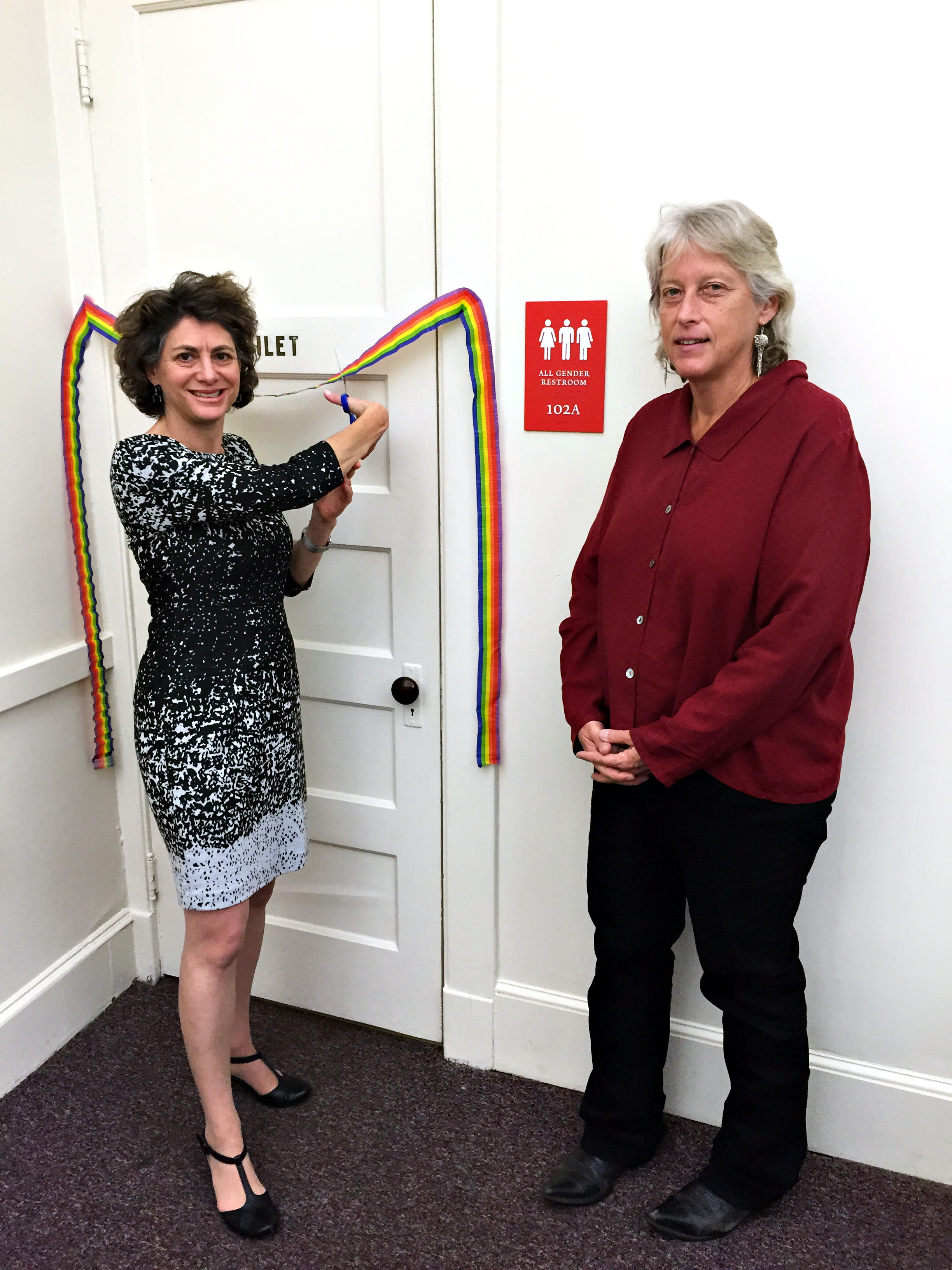
On the first floor of the East Asian Languages building at 432 Temple St., Director of LGBTQ Resources Maria Trumpler, Dean of the Faculty of Arts and Sciences Tamar Gendler and the University’s Chief Diversity Officer Debbie Stanley-McAulay gathered Wednesday to cut a rainbow-colored ribbon in celebration of a recent project to put up gender-neutral restroom signs in 23 Yale buildings.
The new signs -— which feature a female, male and gender-neutral figure, as well as the words “All Gender Restroom” — have been installed over the past month and can now be found at locations indicated on the new All Gender Restroom Map on the Office of LGBTQ Resources website. The signage initiative is part of a larger joint initiative by the Office of LGBTQ Resources, the FAS Dean’s Office, the Office of the Provost, University Planning and the Office of Facilities to establish more gender-neutral restroom spaces on campus to meet the needs of a growing LGBTQ community. The 23 buildings with newly marked restrooms are just a small fraction of the 119 buildings on Yale’s campus with gender-neutral restroom spaces, but the remaining buildings’ restrooms are still marked by the traditional “Male/Female” signage, despite functioning as gender neutral spaces.
Trumpler told the News she has been working to increase the number of gender-neutral restrooms in Yale buildings for a decade, often one at a time as needed. This particular project was set in motion last year, and University Planning conducted a census over this past summer that identified restrooms in 23 Yale buildings that only required a sign change to become effectively “gender-neutral.” Currently, according to Trumpler, over 60 percent of Yale buildings have at least one such restroom.
“This is a crucial project to undertake,” Trumpler said. “Students, staff, faculty and visitors are unfortunately often challenged when someone believes they are using the ‘wrong’ bathroom. Everyone deserves … to [use] a bathroom they can access in peace.”
Isaac Amend ’17, who identifies as transgender, said the lack of gender-neutral restrooms has made his experience using Yale spaces uncomfortable due to his gender variance. Nat Aramayo ’17, who identifies as transgender and prefers “they” pronouns, expressed a similar sentiment, adding that they are sometimes forced to restructure their day or change their walking routes in order to access a restroom in a public building that they feel comfortable using.
“Especially when I’m wearing clothing that is gender nonconforming, I feel uncomfortable using men’s bathrooms … and sometimes I wait to find a gender-neutral or emptier bathroom to use instead of going to the closest male bathroom,” said a Yale College student who asked to remain anonymous because they are genderqueer. “I have felt completely uncomfortable using the men’s [bathroom] the few times I’ve worn a dress in public, one time using the women’s [bathroom] instead due to the lack of a gender-neutral bathroom in the building.”
The student added that gender-binary restrooms have made social transitions difficult for genderqueer and transgender members of the Yale community.
Nevertheless, Gendler said the signage initiative is indicative of the administration’s efforts to ease those difficulties.
“The language of ‘all gender’ and the inclusion of the three icons in this picture — the fact that it is official Yale signage that went through every single part of the Yale process — means that this [project] is done with the approval at the very highest levels,” Gendler said. “These signs are deliberately public and bright because they are a way of indicating that we are a welcoming campus.”
She added that creating gender-neutral restroom spaces is a high priority for the University.
Genderqueer and gender-nonconforming students interviewed expressed their hope for more progress in the number of gender-neutral restrooms. Amend said he believes it is financially feasible for the University to have a gender-neutral restroom in every Yale building on campus. However, Gendler said targeting the 81 other Yale buildings that currently do not have gender-neutral restrooms would be more challenging, since many Yale buildings are under historic preservation regulations and constructing new gender-neutral spaces would be more costly than printing and changing signs.
Still, students and administrators alike told the News that they view the project in a mostly positive light, especially in terms of its impact on both the LGBTQ and the larger Yale communities. The developments in identifying and creating physical spaces that can accommodate gender nonconforming individuals must be supplemented by efforts to raise awareness and promote inclusivity, added the anonymous genderqueer student.
“[Gender-neutral bathrooms] promote a greater understanding of these non-cis identities among cis communities,” Adrien Gau ’17, who identifies as gender-neutral, said. “It provides a great yet unobtrusive segue into a really important conversation to have about sexual and gender identities, especially for people who otherwise wouldn’t be exposed to these things.”
According to Gendler, the project cost around $7,000 total for the design and production of the signs.







